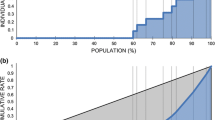Abstract
We compare DNA mixture analysis via DNAˑVIEW® Mixture Solution™ and the current combined probability of inclusion (CPI) method of the South African Police Service (SAPS). South Africa has a high incidence of property-related crimes and sexual offences and consequently a great deal of low-template (LT-DNA) forensic DNA mixture casework and a perpetual backlog. A range of casework and laboratory-prepared sexual assault mixtures with initial male DNA amounts varying from about 2 to 200 cells were analysed to evaluate the benefits of a continuous model program. Unfortunately CPI methods are nearly useless for LT-DNA cases because of dropout—common from a mixture contribution of fewer than 20 or 30 cells. We further argue that proposed CPI elaborations to circumvent dropout lack supporting research or even explanation. Mixture Solution models mixture data as continuous rather than binary, with a mathematically coherent (“probabilistic”) model which incorporates dropout and other phenomena realistically. Much more information is thereby utilised resulting in applicability to more cases (7 or fewer contributor cells suffice), stronger evidence against a suspect who is a mixture contributor and stronger evidence to absolve a non-contributor. Mixture Solution incidentally provides information which, along with rfu data, allows estimating contributions in terms of number of cells, which is a useful perspective. The method of calculation is explained.







Similar content being viewed by others
Notes
Clearly detection threshold is related to analytical threshold (AT) since AT, defined as “the level above which signals can safely be assumed to be legitimate”, is an obvious choice for DT. But the terms are not synonymous. An analyst may choose and compute with various DT levels, whereas the definition of AT implies a fixed level imposed by nature.
References
NRC (1996) The evaluation of forensic DNA evidence. National Academies Press, Washington (DC)
Kelly H, Bright JA, Buckleton JS, Curran JM (2014) A comparison of statistical models for the analysis of complex forensic DNA profiles. Sci Justice 54:66–70. https://doi.org/10.1016/j.scijus.2013.07.003
SAPS (2018) Crime report addendum to the SAPS annual report. https://www.saps.gov.za/about/stratframework/annual_report/2018_2019/annual_crime_report2020.pdf. Accessed 2 Nov 2020
Michaelis R, Flanders R, Wulff P (2008) A litigator’s guide to DNA, 1st edn. Academic Press, Massachusetts
Brenner CH, DNAˑVIEW® Mixture SolutionTM. https://dna-view.com/downloads/Mixture%20Solution%20poster.pdf. Accessed 1 Mar 2019
Buckleton J, Bright J, Gittelson S et al (2019) The Probabilistic Genotyping Software STR mix: utility and evidence for its validity. J Forensic Sci. https://onlinelibrary.wiley.com/doi/pdf/10.1111/1556-4029.13898
Perlin MW, Legler MM, Spencer CE et al (2011) Validating TrueAllele® DNA Mixture Interpretation. J Forensic Sci 56:1430–1447. https://doi.org/10.1111/j.1556-4029.2011.01859.x
Ladd C, Lee HC, Yang N, Bieber FR (2001) Interpretation of complex forensic DNA mixtures. Croat Med J 42(3):244–6
Budowle B, Onorato AJ, Callaghan TF et al (2009) Mixture interpretation: defining the relevant features for guidelines for the assessment of mixed DNA profiles in forensic casework. J Forensic Sci. https://doi.org/10.1111/j.1556-4029.2009.01046.x
Bieber FR, Buckleton JS, Budowle B et al (2016) Evaluation of forensic DNA mixture evidence: protocol for evaluation, interpretation, and statistical calculations using the combined probability of inclusion. BMC Genet. https://doi.org/10.1186/s12863-016-0429-7
Scientific Working Group on DNA Analysis Methods (2017) Scientific Working Group on DNA Analysis Methods Interpretation Guidelines for Autosomal STR typing by Forensic DNA Testing Laboratories. 1–90
Gill P, Brenner CH, Buckleton JS et al (2006) DNA commission of the International Society of Forensic Genetics: recommendations on the interpretation of mixtures. Forensic Sci Int 160:90–101. https://doi.org/10.1016/j.forsciint.2006.04.009
Morris JW (1984) Relationship between power of exclusion and probability of paternity. In: Walker RH (ed) International Conference on Inclusion Probabilities in Parentage Testing. American Association of Blood Banks, Arlington, pp 267–276
Butler JM (2012) Advanced topics in forensic DNA typing: methodology. Elsevier, New York
Lucassen A, Ehlers K, Grobler PJ, Shezi AL (2014) Allele frequency data of 15 autosomal STR loci in four major population groups of South Africa. Int J Legal Med 128:275–276. https://doi.org/10.1007/s00414-013-0898-4
Coble MD, Bright JA (2019) Probabilistic genotyping software: an overview. Forensic Sci Int Genet 38:219–224. https://doi.org/10.1016/j.fsigen.2018.11.009
Author information
Authors and Affiliations
Corresponding author
Ethics declarations
Ethics approval
All procedures performed in studies involving human participants were in accordance with the ethical standards of the institutional and/or national research committee and with the 1964 Helsinki Declaration and its later amendments or comparable ethical standards.
Informed consent
Individuals who donated blood samples gave their signed informed consent. The anonymity of the individuals investigated was preserved.
Conflict of interest
The Mixture Solution software is a creation of the paper’s last author. Otherwise, the authors declare no competing interests.
Additional information
Publisher’s note
Springer Nature remains neutral with regard to jurisdictional claims in published maps and institutional affiliations.
Rights and permissions
About this article
Cite this article
Lucassen, A., Ehlers, K., Grobler, P.J. et al. Evaluating Mixture Solution™— rapid and non-MCMC probabilistic mixture analysis. Int J Legal Med 135, 2275–2284 (2021). https://doi.org/10.1007/s00414-021-02680-2
Received:
Accepted:
Published:
Issue Date:
DOI: https://doi.org/10.1007/s00414-021-02680-2




